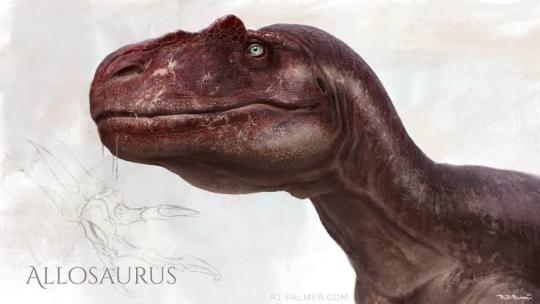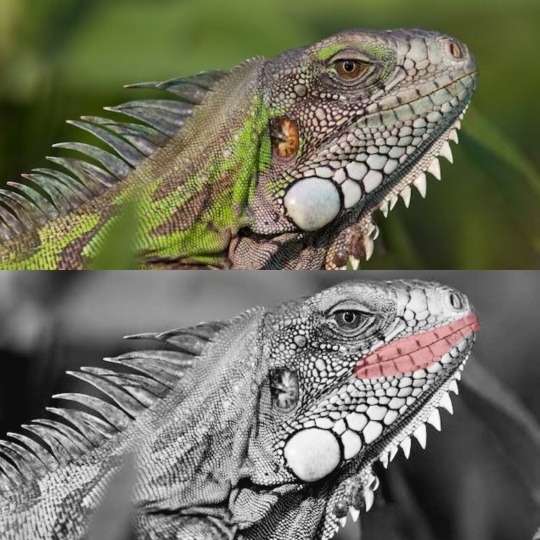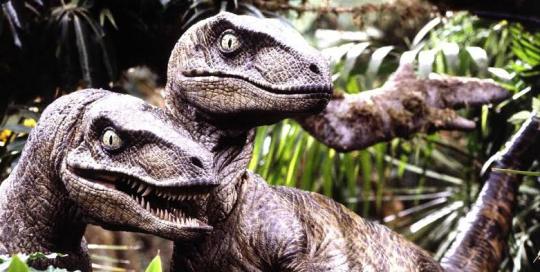#labial foramina
Explore tagged Tumblr posts
Text
Thursday 17/6/21 - The Dinosaur Lip Debate

Allosaurus, RJ Palmer
Palaeontology is an ever evolving field. Every time a new fossil is found, or the technology to observe them improves, we find out something new about how the animals looked or behaved. As more details are filled in, the discussion has turned more toward soft body parts, such as the toes, and the face.
I know I said yesterday's post was my dinosaur post for the week, but I got an inbox from a reader asking if I could talk about the Lip Debate, so I thought I'd weigh in on what I know. Thanks for the suggestion @amphibious-owl.
Reptile Lips?
When I say the word lips, you'd immediately think of those luscious smoochers that a human has right? But the term "lip" refers to any fleshy, flexible covering of the teeth in vertebrate animals. Some existing reptile groups have lips, namely squamates (lizards and snakes), so it is possible that dinosaurs had them.

Green Iguana, Bottom Picture highlights Lips in Red
The problem is that the closest living relatives of dinosaurs, birds, have beaks instead. And while it is possible that beaks evolved from lips, the dinosaur's second closest living relatives, crocodilians, have lipless mouths, where teeth are visible when the mouth is closed. If they didn't have lips before diverging from crocodiles, they probably didn't evolve them and then lose them before getting to birds (as the argument goes). This is the start of the debate.

Top: Saltwater Crocodile, displaying the lipless condition
Bottom: Blue Jay, displaying a toothless beak
Reconstructions in Pop Culture
The debate is mostly about therapod dinosaurs, because many groups of herbivorous dinosaurs have beaks and rear teeth that would've been hidden by fleshy cheeks. I didn't mention the use of lips in dinosaur reconstructions during my earlier article, Your Dinosaurs Are Wrong, because different media have showed both the lipped and lipless condition in different dinosaurs. And at present, scientists aren't sure which is correct.

Top: Jurassic Park Velociraptor, reconstructed with fleshy lips
Bottom: Jurassic Park T.rex, reconstructed with exposed teeth

The Palaeontological Debate
• Phylogenetic Bracketing
As mentioned above, the two groups most closely related to extinct dinosaurs do not have lips. Because dinosaurs were bracketed between these two groups, it is easy to come to the conclusion that liplessness is an ancestral condition to all three. Inferring traits from both ancestors and descendants is called Phylogenetic Bracketing.

Comparison of Crocodile Jaws to Tyrannosaurus Jaws (Scott Hartman)
This particular argument has its counter, because the shape and placement of teeth on jaws of crocodiles and therapod dinosaurs differs greatly. Crocodile teeth are angled outwards, a specialisation for fish eating, and lips would get in the way. Dinosaur teeth are almost vertical relative to the skull, and the upper and lower teeth did not interlock at all.
• Jaw-bone Foramina
The debate has reached its head in recent years because palaeontologists have found that markings on the edges of the jaw bones of different animals can correspond to the presence of lips in a living animal. These holes, called labial foramina, allow for placement of blood vessels and nerves around the mouth of the animal. All vertebrate skulls have these, the question is on how numerous they are.

Labial Foramina on Tyrannosaurus, highlighted as red dots (Scott Hartman)
In crocodiles, there are many foramina around the teeth, and in several extant groups, this has coincided with exposed teeth. Some dinosaur groups, such as Tyrannosaurs and Spinosaurs, have lots of these foramina too, so some think this means that they had a crocodile-like face.
Other palaeontologists think that again, crocodiles are poor analogues because the surface of a crocodilian skull is rough in general (refer to the image previous) whereas therapod skulls are only rough around the jaws. These holes may indicate attachment points for fleshy coverings for the larger teeth as they overlap when the dinosaur closes its mouth.
• Variation within Therapoda?
The answer may not be as simple as a yes or no, but maybe a who did and who didn't. I mentioned above that Tyrannosaurus and Spinosaurs in particular have been selected as groups likely for liplessness, but maybe it was just that they were the outliers. Many therapods, including dromeosaurs (raptors) had a more conservative number of foramina, more aligning with the skulls of animals we do know had lips.

Top: Velociraptor Jaw Structure, Henry Osborn
Bottom: Lipped Velociraptor, John Conway

Spinosaurus in particular has been under scrutiny on its lips as of late, (but Spinosaurus is always under scrutiny). And although some have suggested it had lips, since it has a similar skull and lifestyle to crocodilians, maybe their fleshy faces were similar too.

3 different reconstructions of Spinosaurus Lips , MarkM98 on DeviantArt
What's the Right Answer?
To sum up this post, we just don't know yet. My personal take is that some dinosaurs may have had lips, and others were less likely to. But we cannot be 100% certain on any one species' lip condition until we find soft tissues preserved.
If you want to look further into the topic, here's a couple articles from people more educated on the topic:
Mark Witton; "Did Tyrannosaurs Smile like Crocodiles?"
Scott Hartman; "The Lip Post"
And here's a long-ish Youtube video also covering the topic, that I found very informative:
Ben G Thomas; "Did T.rex Have Lips?"
Thankyou for reading, and I hope that you found this post informative. I have a few more dinosaur-related posts on this blog, so happy reading.
111 notes
·
View notes